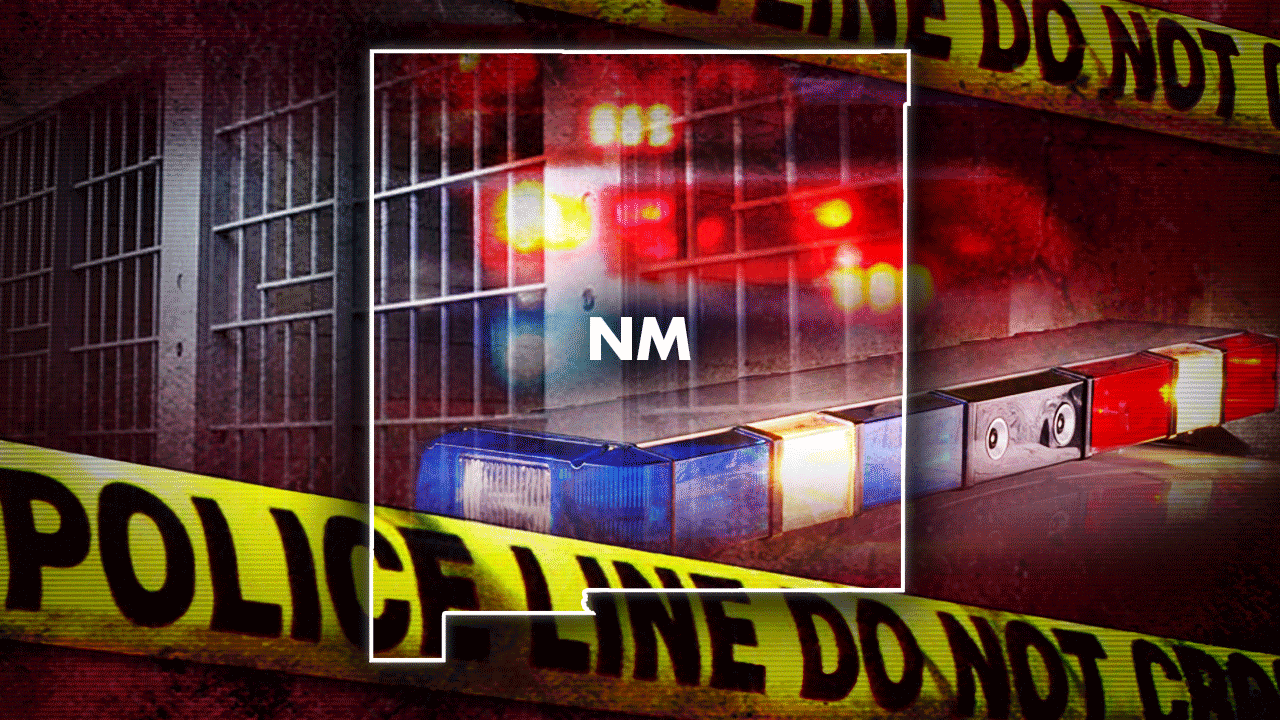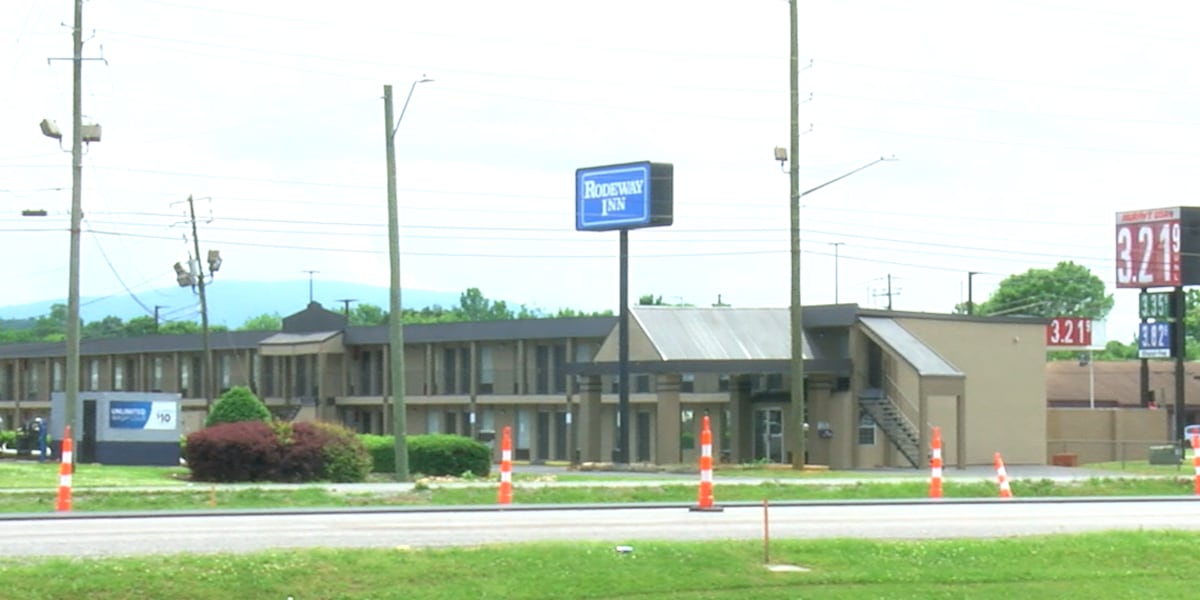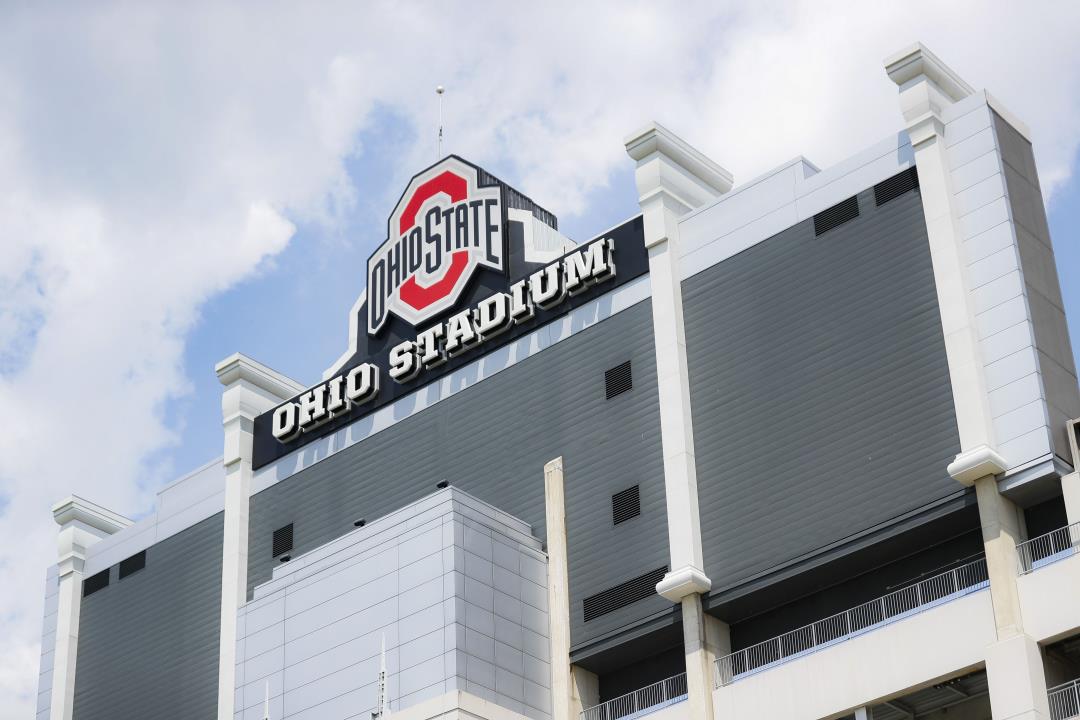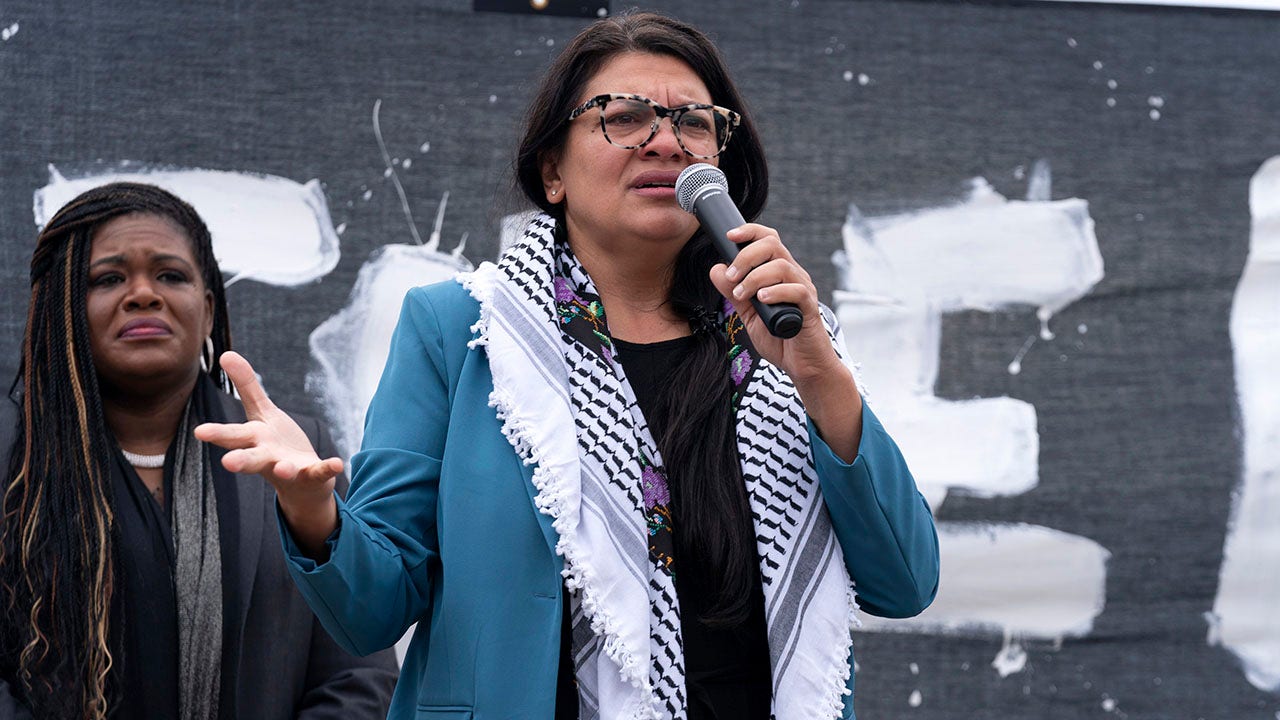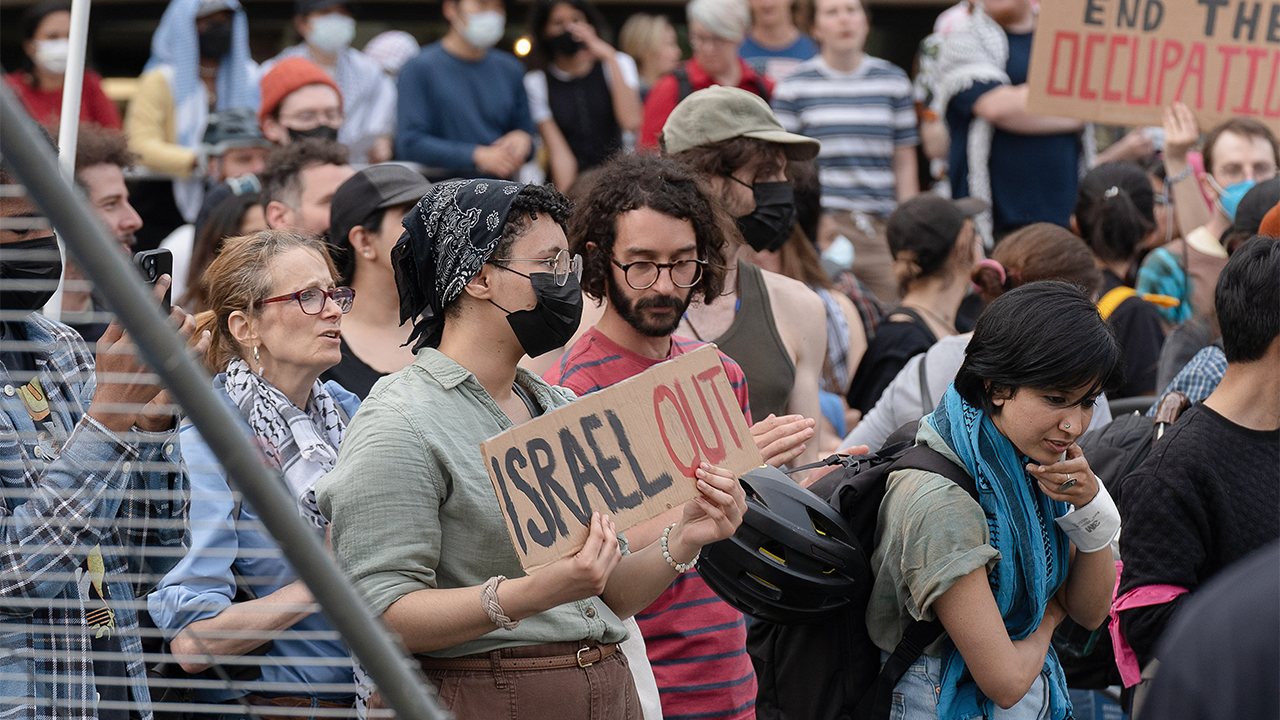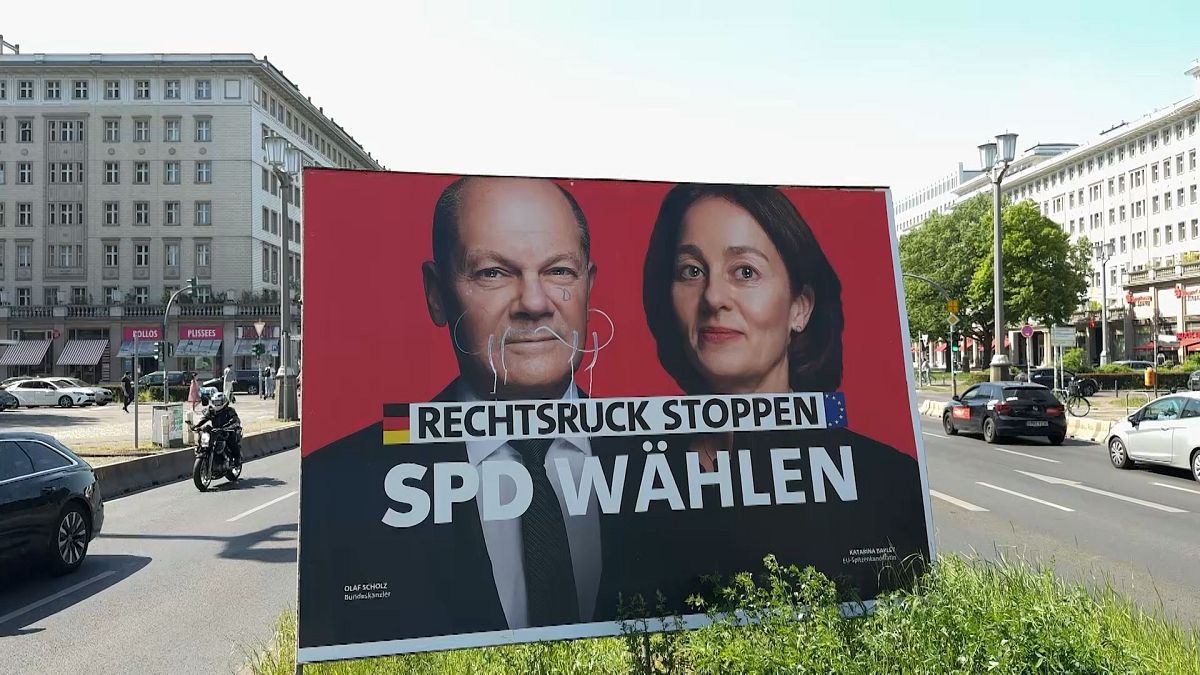World
Has South Africa Truly Defeated Apartheid?

Thirty years ago, the South African miracle came true. Millions voted in the country’s first democratic elections, seemingly delivering a death blow to apartheid.
The African National Congress rose to power under the leadership of Nelson Mandela and used the Freedom Charter, a decades-old manifesto, as a guide to forming a new nation.
The charter’s 10 declarations offered a vision for overcoming apartheid through a free, multiracial society, with quality housing, education and economic opportunities for all.
As South Africans celebrate 30 years of freedom and prepare to vote in a pivotal national election, we looked at how far the country has come in meeting the Freedom Charter’s goals.
When the apartheid government was toppled in South Africa, ending white minority rule, people around the world shared in the excitement and optimism that a more just society would emerge. A generation later, the country’s journey provides a broader lesson: It is far easier to rally for an end to racism than it is to undo entrenched inequities and to govern a complicated country.
The African National Congress won the 1994 election on the promise of “a better life for all.” But for many that promise has fallen short. Polls now suggest that in the election scheduled for May 29, the party risks losing its absolute majority in the national government for the first time.
No one doubts that South Africa has made strides since the days of legalized racial oppression. Democracy has brought a growing Black middle class, access to better education across racial lines and a basic human dignity once stolen from the Black majority.
But there also has been a widening gap between rich and poor, a breakdown in basic services like electricity and water, and the continued isolation of Black families stuck in ramshackle homes in distant communities.
Black South Africans, who make up 81 percent of the population, often argue that they’ve gained political freedom, but not economic freedom — and remain trapped in the structure of apartheid.
We went through the Freedom Charter’s declarations — each ending in an exclamation point — to measure South Africa’s progress and shortcomings over the past 30 years.
The ideal
THE PEOPLE SHALL GOVERN!
The reality Democracy is stable, but South Africans are disillusioned, and most no longer vote.
Sources: Collette Schulz-Herzenberg, “The South African non-voter: An analysis”; Konrad Adenaur Stiftung, 2020 (South Africa); Pew Research (United States and U.K.)
On a continent where coups, autocrats and flawed elections have become common, South Africa is a widely admired exception.
Since 1994, the country has held national elections every five years, with local elections in between. Presidents have changed, but the party in power — the A.N.C. — never has. Despite this, there have never been any serious doubts about the integrity of those electoral contests. A record 52 parties will compete in the national election this year.
Despite the electoral stability, politics have been dangerous. Fierce conflict within the A.N.C. has resulted in many assassinations over the years. The A.N.C.’s access to state resources as the governing party has fueled many of the disputes and led to widespread corruption — from top national officials down to local councilors.
The enrichment of A.N.C. leaders while many people barely earn enough to feed themselves has shaken the faith of many South Africans in their democratic system.
Last year, 22 percent of South Africans approved of the functioning of the country’s democracy, down from 63 percent in 2004, according to surveys from the Human Sciences Research Council.
The ideal All National Groups Shall Have Equal Rights!
The reality
Society is free and equal on paper, but economic barriers endure.
Under apartheid, race restricted every aspect of life for South Africans who were Black, Indian and colored — a multiracial classification created by the government. There were strict limits on where they could live, attend school, work and travel. Laws enforced this segregation, and partaking in politics was criminalized.
But the democratic government drafted a constitution that enshrined equal rights for all.
South Africa has become a place where people of all races often dine, worship and party together. Gay rights are largely accepted. There is a free and vigorous press, and protests and open political debate are a part of life.
But many of the economic barriers created under apartheid still endure.
By one measure, the World Bank has ranked South Africa as the most unequal country in the world. Ten percent of the population holds about 71 percent of the country’s wealth, while the bottom 60 percent holds just 7 percent of assets, according to the World Bank.
To a large extent, the wealth disparities have kept millions of Black South Africans relegated to some of the most deplorable conditions.
Just look at the place in the Soweto community of Kliptown where hundreds of anti-apartheid activists gathered to draft the Freedom Charter in 1955. It is now known as Walter Sisulu Square, named for a prominent anti-apartheid activist.
Nearly two decades ago, the government built a large concrete complex around the square, with restaurants, offices and a hotel. But because of a lack of maintenance and huge riots in 2021 that stemmed from political grievances, most of the businesses are now gutted, littered and stinking of sewage. Informal traders eke out a living nearby selling sandwiches, clothes and fruit.
Across adjacent railroad tracks sits an all-Black neighborhood where most residents live in tin shacks, use outdoor latrines, rely on jury-rigged wires for electricity and navigate craggy dirt roads.
Walter Sisulu Square in Kliptown, Soweto, where South Africa’s Freedom Charter was signed in 1955, is now dilapidated.
Joao Silva/The New York Times
Jack Martins, 54, who lives in the neighborhood, had a cellphone repair shop in the complex, but it did not survive the riots. He now plies his trade from a table on the sidewalk. He secured public housing, but had to pay a bribe to get it, he said. Two of his sons could not get into university because there was not enough space, and his daughter, despite having a mechanical engineering degree, has been unable to find stable work. He is fed up with the near-daily, hourslong electricity outages caused by the failing state power utility.
“What is this government doing for us?” he said. “Absolutely nothing.”
The ideal
The People Shall Share in the Country’s Wealth! The reality
A wide economic gulf persists between Black and white South Africans.
The Black middle and upper classes have grown significantly. In 1995, just 350,000 Black South Africans lived in households that were among the top 15 percent in income, according to researchers at the University of Cape Town’s Liberty Institute of Strategic Marketing. By 2022, that number had grown to about 5.6 million.
Still, Black families are underrepresented among rich households.
Many expected something better this far into democracy. Much of the nation’s wealth remains in white hands.
Black South Africans had a stake in only 29 percent of the companies listed on the Johannesburg Stock Exchange, according to a 2022 report by South Africa’s Black Economic Empowerment Commission. Not a single entity on the exchange was fully Black-owned, the report said.
Economists say the country’s economy never took off enough to allow for a greater redistribution of wealth. Even when South Africa experienced its strongest stretch of economic growth in the first decade and a half of democracy, it still lagged behind its peers in Africa and other upper-middle-income countries. Since then, growth has been tepid, and contraction since the Covid-19 pandemic has been sharper than that in similarly sized economies.
Sources: Harvard Growth Lab analysis of World Economic Outlook (South Africa and sub-Saharan Africa) and World Development Indicators (upper-middle-income countries).
Government rules have allowed Black South Africans to gain a greater stake in industries like mining, where Black ownership has grown from 2 percent to 39 percent over the past two decades. But the gains have gone to relatively few people at the top.
However, the Bafokeng kingdom, an ethnic group within South Africa, has shown what is possible when a community gets its fair share of its resource wealth. The kingdom sits on rich platinum deposits. After a court victory in 1999 that affirmed its land rights, the kingdom used its platinum dividends to build a school with a large campus and a modern clinic, and to invest in other industries. Most families live in large brick homes that are the envy of other rural villages.
The ideal
The Land Shall Be Shared Among Those Who Work It!
The reality White South Africans continue to own most of the land.
At the end of apartheid, when almost all of South Africa’s agricultural land was white-owned, Mr. Mandela’s government pledged in 1994 to transfer 30 percent of it into Black hands within a few years, by encouraging white landowners to sell.
The government failed to meet its goal, and it stretched the deadline to 2030. So far, about 25 percent of white-owned farmland has been transferred to Black ownership, mostly through the purchase of land by the government or Black individuals, according to Wandile Sihlobo and Johann Kirsten, agricultural economists at Stellenbosch University.
White South Africans make up roughly 7 percent of the population, but white-owned farms still cover about half of the country’s entire surface area, according to Mr. Sihlobo and Mr. Kirsten.
A worker on a Black-owned farm letting out cattle to graze near Carletonville, South Africa.
Joao Silva/The New York Times
In the first decade of democracy, the government gave Black people full ownership of the white-owned farms it had bought. Owning the land meant that Black families had the chance not only to feed and support themselves but also advance.
But the government is no longer giving land to Black South Africans outright, offering long-term leases instead, Mr. Sihlobo and Mr. Kirsten said. Without ownership, Black farmers cannot generate wealth by using the land as collateral to get a bank loan. That has prevented Black farmers from expanding their operations to be commercially competitive.
Only about 7 percent of commercial-scale farms — those that sell to major grocers or export their products — are Black-owned. Only about 10 percent of the food produced by commercial farms in South Africa comes from Black-owned farms, about the same share as in the 1980s, Mr. Sihlobo said.
In the first decade of democracy, more than 930,000 mostly Black and colored farm workers were evicted from farms despite new laws intended to allow them to spend their lives on the farms where they worked.
“We haven’t been able to live up to those ideals” of Black land ownership, Mr. Sihlobo said.
The ideal
There Shall Be Work and Security! The reality
Unemployment has risen since the end of apartheid.
Black South Africans are unemployed at far higher rates than their white peers, and that disparity has not improved over time.
Source: Statistics South Africa Note: Graphic shows the expanded definition of unemployment, which includes those discouraged from seeking work.
The high unemployment rate has given rise to a hustle culture that sends many South Africans to the streets early each morning in search of work.
Zinhle Nene, 49, has been waking up by 5:30 a.m. most days and waiting on a corner in downtown Johannesburg with hundreds of others seeking day jobs. She left her low-paying job as a home health aide because the transportation to work was too expensive.
“It’s heartbreaking because we come here and we don’t even have food,” she said, wiping away tears as the hours passed. “Sometimes, you even get home, there’s nothing. You just drink water and then you sleep.”
Poverty has decreased since the start of democracy. Still, it remains very high. Nearly two out of every three Black South Africans lived below the upper-bound poverty line in 2015 — the most recent data available — meaning they had access to less than about $80 a month. Only 1 percent of white South Africans lived below that line.
The ideal
There Shall Be Houses, Security and Comfort!
The reality
Millions of new homes were constructed, but hardly enough.
Peter Mokoena broke down in tears last November inside the modest two-bedroom house the government had just given him. It sat alongside dozens of other homes just like it, on the freshly paved roads of a new subdivision about half an hour southeast of Johannesburg.
“I’m so happy, happy, happy, happy for this house,” said Mr. Mokoena, 74, who had been living in a tin shack so leaky that his furniture was soaked when it rained. “Now, it feels like I’m in heaven.”
The government has built 3.4 million houses since 1994, and given ownership of most of them for free to poor South Africans. Some units, known as social housing, are rented out at below-market rates. The government also has embarked on several “mega city” projects, in partnership with the private sector, to cluster together various types of housing and services like day care centers.
Many South Africans have moved into formal homes from makeshift structures, and access to basic services like electricity and piped water has increased. But frequent power and water outages have made those services unreliable, leading to anger and frustration nationwide.
Mr. Mokoena waited 27 years for his house. Many are still waiting. In the meantime, some squat in downtown buildings. Others build shacks in any open space they can find. Or they rent small backyard units built behind houses — an effort the government is supporting.
New government housing has often ended up in areas far from jobs and economic activity, perpetuating the apartheid system of marginalizing Black people to outlying townships.
Sources: Spatial Tax Panel (employment data); WorldPop (population density)
Note: The area outlined in yellow represents parts of Johannesburg with at least 10,000 full-time equivalent employees in formal employment.
The ideal
The Doors of Learning and Culture Shall Be Opened!
The reality
Education is open to all, but quality and seats are falling short.
Nokuthula Mabe anxiously sat on her suitcase in the February heat outside North-West University in the city of Mahikeng, waiting with about a dozen other high-school graduates hoping for a spot. The university had received more than 181,000 applications for 11,717 slots.
In many ways, Ms. Mabe epitomized post-apartheid progress simply by graduating from her overcrowded village school near the Botswana border.
Nokuthula Mabe, right.
Joao Silva/The New York Times
In the 1950s, only 10 percent of Black children finished high school. By 2021, that number had risen to 58 percent, according to government statistics.
Despite these gains, significant racial disparities persist.
Sources: Equal Education Law Centre analysis of data from Statistics South Africa General Household Survey; Department of Basic Education
Note: Shows share of 22- to 25-year-olds who have completed at least grade 12 or equivalent.
In 1982, the apartheid government spent roughly $1,100 a year on education for each white child but just $140 for each Black child, according to Section 27, a human rights organization.
By 2018, that had increased to about $1,400 for each child, according to researchers at Stellenbosch University, much of it intended to level the playing field for Black students.
But schools are still failing many of their students. A report published in 2022 found that 81 percent of Grade 4 students could not understand what they were reading.
And while more children are finishing high school, there are not enough seats in colleges to meet the demand.
In 2022, about 6 percent of South Africans aged 18 to 29 were enrolled in higher education, according to Statistics South Africa. These enrollment rates lag behind countries with similarly sized economies, like Brazil, Mexico and the Philippines, according to figures from the World Bank.
After waiting nervously for hours, Ms. Mabe, 18, dragged her suitcase to the nearest bus stop to begin the three-and-a-half-hour trip back to her village. The university was too full to admit her.
The ideal
All Shall Be Equal Before the Law!
The reality
Courts are widely seen as credible, but money makes a difference.
During apartheid, the judicial system was used to criminalize Black people, mete out harsh punishment and cover up the atrocities committed against them.
Today, the judiciary is seen as among the most credible institutions in the country. Judges have upheld human rights and taken tough stances against even powerful political figures like the former president Jacob Zuma, who was sentenced to prison for contempt.
Still, as in many other countries, the South African justice system works best for those with money. A government commission found two years ago that most South Africans could not afford legal fees. The agency providing legal assistance for the poor is underfunded and overburdened.
“Those with very deep pockets are able to take the criminal justice process, stretch it for a very long period of time,” said Chrispin Phiri, a spokesman for the Ministry of Justice and Correctional Services. “That’s a privilege not afforded to a poorer person.”
What’s more, the justice system does not seem to be taming the country’s high crime rate.
Sources: The Institute for Security Studies (South Africa); the World Bank (other countries, 2021 figures)
Although the murder rate is lower than it was in 1994, it has climbed steadily since 2012.
On paper, South Africa’s legal system prioritizes rehabilitating prisoners. The government offers an array of restorative justice, jobs and counseling programs for inmates and those being released.
In reality, though, prison-reform activists and studies suggest that treatment behind bars can be harsh and access to education difficult.
The ideal
There Shall Be Peace and Friendship!
The reality
South Africa has grown bold in trying to shake up the Western-led world order.
Internationally, South Africa has tried to position itself as a broker of peace and a leader in challenging a Western-led world order.
South Africa is the “S” in the BRICS group of nations that also includes Brazil, Russia, India and China, formed as a counterpoint to American and European alliances.
South Africa has played a critical role over the years in peace missions in African countries like Ethiopia, Burundi and Zimbabwe. And President Cyril Ramaphosa led a peace delegation last year to Ukraine and Russia, while refusing to condemn the Russian invasion of Ukraine.
President Cyril Ramaphosa in 2021. Joao Silva/The New York Times
South Africa argues that as a midsize nation, it cannot afford to choose sides and must make friends with everyone.
But it has been accused of being hypocritical and selectively concerned about peace and human rights.
The government brought a genocide case this year in the International Court of Justice against Israel for its war in Gaza after the attacks by Hamas on Oct. 7. South African officials have argued that Palestinians face a situation similar to apartheid.
The ideal
All Shall Enjoy Equal Human Rights!
The reality
But they will have to fight for it.
For all of the frustrations that South Africans may have about the past 30 years, democracy has brought something that money and data cannot measure: freedom.
As in, freedom to go where you want, to date whom you want, to complain and advocate change as loudly as you want.
That has driven Sibusiso Zikode, 48, for much of his adult life.
He arrived in Durban, a port city on South Africa’s east coast, and started law school, but dropped out in the first term when his family savings ran out.
Sibusiso Zikode, left, helped establish a protest movement in Durban to advocate on behalf of poor people. Joao Silva/The New York Times
He moved to Kennedy Road, a slum built on muddy slopes and surrounded by a landfill, joining thousands who had flocked to the city for opportunity, only to find themselves in zinc shacks. This didn’t feel like freedom.
So, he helped to establish Abahlali baseMjondolo, a protest movement that is one of many that represent the revolt of poor people. Between July and September in 2022, the South African police responded to 2,455 protests.
But going up against the post-apartheid political establishment has come at great cost: Leaders of Abahlali have been assassinated, and Mr. Zikode had to flee from his home at the squatter camp after deadly attacks.
Abahlali’s members are growing more disillusioned with democracy.
“Whoever is homeless now,” Mr. Zikode said, “will be homeless after the election.”

World
Trump seeks records about evidence handling in latest bid to delay documents case

World
Temporary floating pier for Gaza aid completed, will move into position once weather lets up: Pentagon
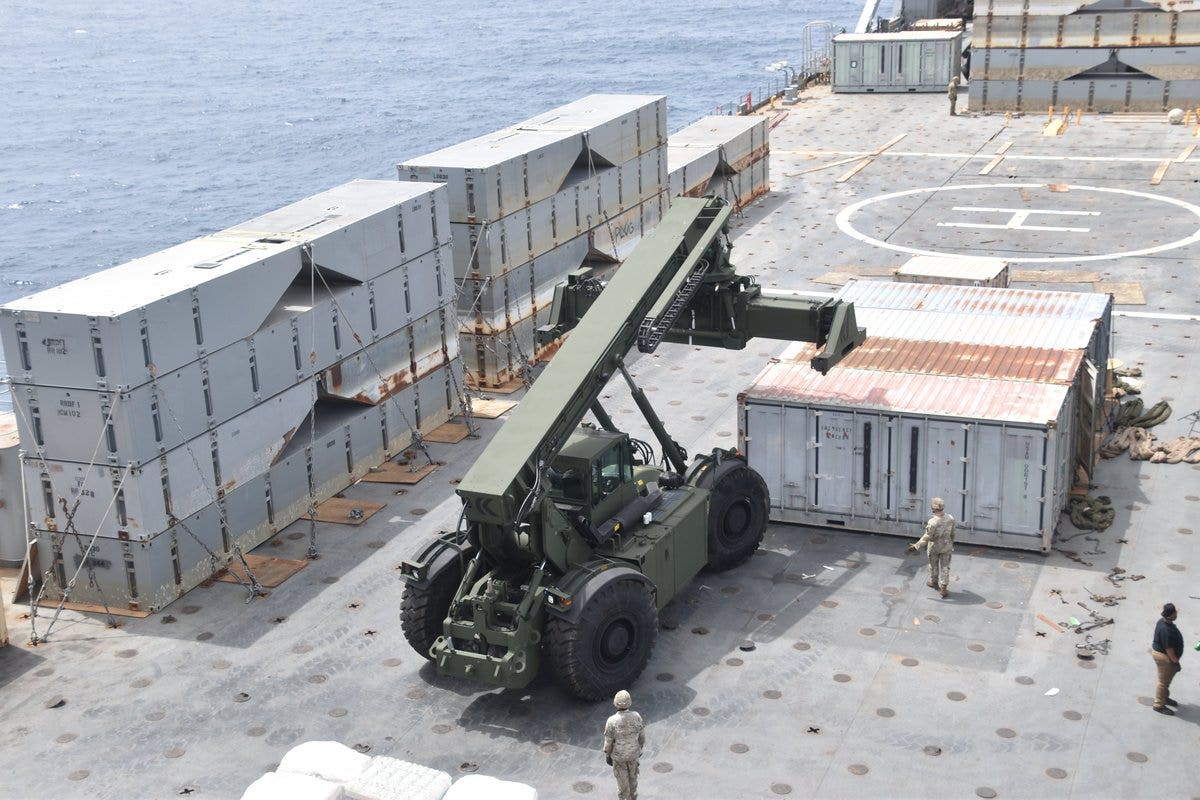
Both sections of the temporary floating pier intended to be placed off the coast of Gaza Strip for the delivery of humanitarian aid have been completed, though weather and sea conditions are preventing delivery of the parts to the embattled region, Pentagon officials tell Fox News.
Pentagon Deputy Press Secretary Sabrina Singh said during a press briefing on Tuesday that the U.S. Military completed the offshore construction of the Trident Pier section, or the causeway, which is the component that will eventually be anchored to the Gaza shore.
The second element of the project, the floating pier section, has also been completed.
“So, as of today, the construction of the two portions of the JLOTS [Joint Logistics Over-the-Shore], the floating pier and the Trident pier are complete and awaiting final movement offshore,” Singh said. “As you know, late last week, CENTCOM [U.S. Central Command] temporarily paused moving the floating pier and Trident pier toward the vicinity of Gaza due to sea state conditions. Today, there are still forecasted high winds and high sea swells, which are causing unsafe conditions for the JLOTS [Joint Logistics Over-The-Shore] components to be moved.”
MORE AID IS SUPPOSED TO BE ENTERING THE GAZA STRIP. WHY ISN’T IT HELPING?
U.S. Central Command tweeted that the construction of the floating Joint Logistics Over-The-Shore pier in the Mediterranean is underway. (CENTCOM)
The components are still sitting at the Port of Ashdod, and CENTCOM “stands by” to relocate the pier sections to Gaza, Singh added.
Once off the coast of Gaza, the U.S. military and USAID will work together to deliver humanitarian assistance using military support vessels and trucks.
Singh could not provide an exact date for when the pier would be maneuvered into place, mainly because of the weather and security conditions.
“As CENTCOM stands by to move the pier into position in the near future, and again, in partnership with USAID, we’re loading humanitarian aid onto the MV Sagamore, which is currently in Cyprus,” she said. “The Sagamore is a cargo vessel that will use the JLOTS system and will make trips between Cyprus and the offshore floating pier, as USAID and other partners collect aid from around the world.”
GROWING CONTROVERSY OVER BIDEN’S GAZA PIER FUELS CONCERNS OVER COST, SECURITY
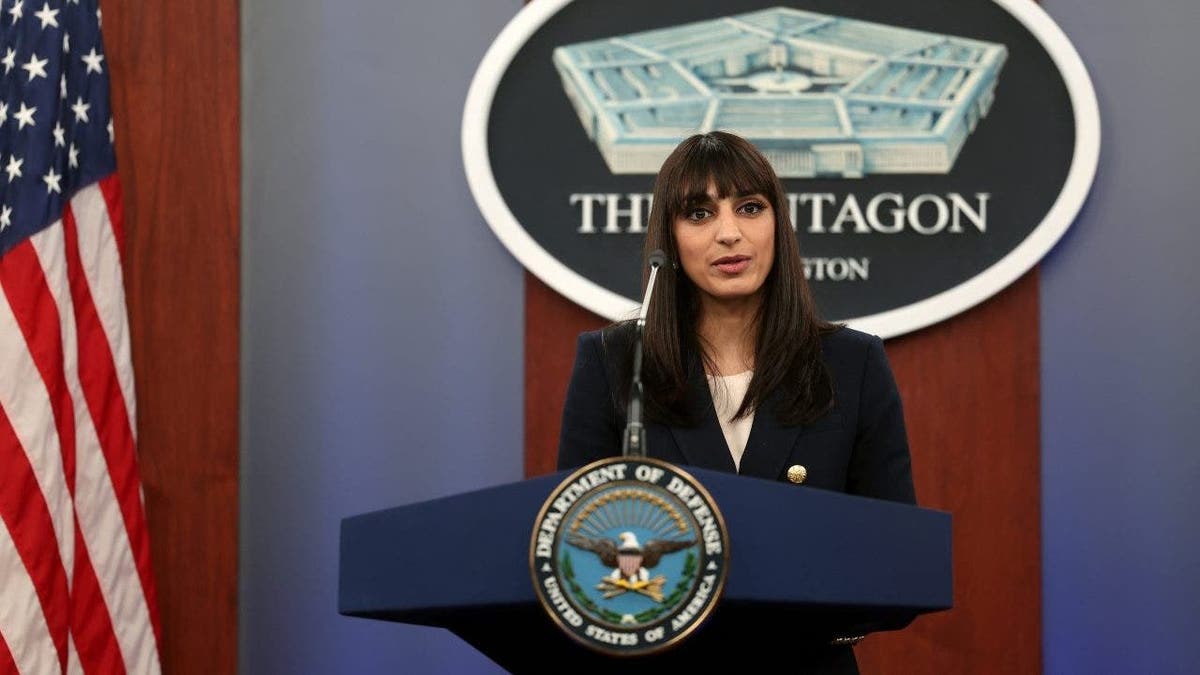
Pentagon Deputy spokesperson Sabrina Singh holds a press briefing at the Pentagon in Arlington, Va. (Kevin Dietsch/Getty Images)
The unloading of the aid will be, as she called it, a “crawl, walk, run scenario.”
Once fully operational, 150 trucks will be available to move aid into Gaza. At first, though, a small number of trucks will be used to make sure the distribution system works.
BIDEN’S VISION FOR A PALESTINIAN STATE DOOMED, EXPERTS SAY: ‘AN EXPLICIT RECOGNITION OF HAMAS’
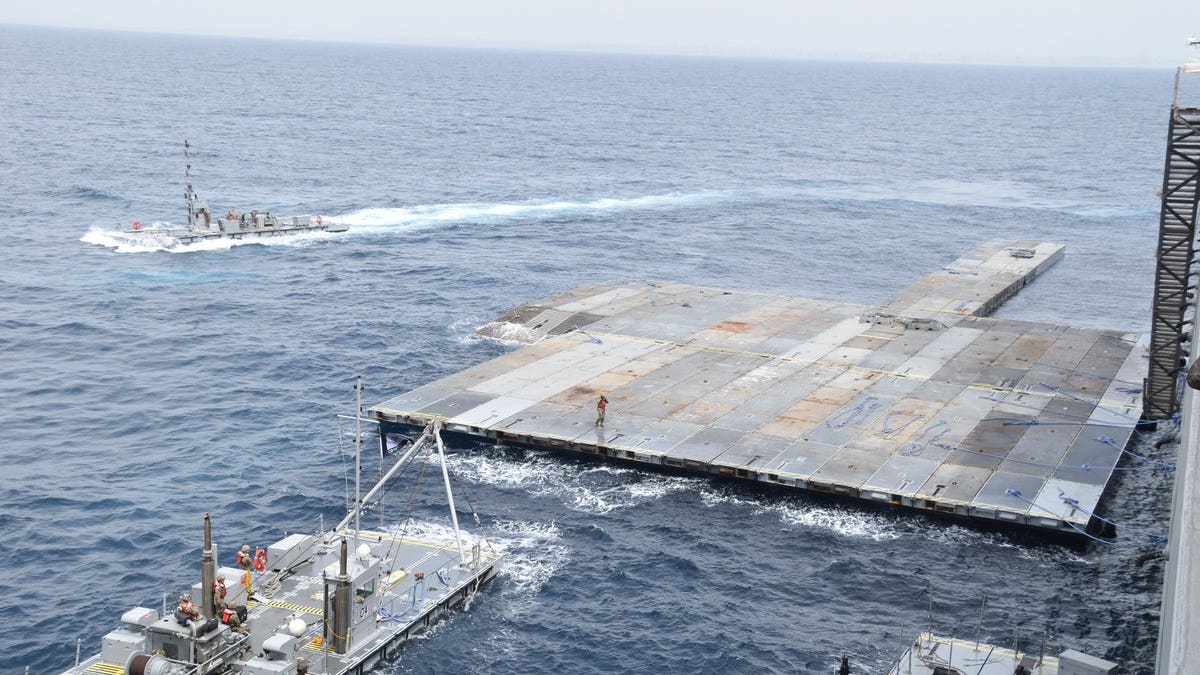
CENTCOM tweeted on X that, ‘The pier will support @USAID and humanitarian partners to receive and deliver humanitarian aid to the people of Gaza. @USTRANSCOM and @USEUCOM support the movement of #humanitarianaid. (CENTCOM)
Last week, U.S. Central Command posted photographs on X of the pier under construction by U.S. soldiers in the Mediterranean Sea, saying that the hulking metal platform “will support USAID and other humanitarian partners who will receive and deliver humanitarian aid to the people of Gaza.”
The Pentagon has said the estimated cost would nearly double the original estimate of $180 million. It also said the project will only be in use temporarily, for a period of three months.
The pier will be able to process up to two million meals a day for the people in Gaza, U.S. Central Command said.
Ruth Marks Eglash of Fox News contributed to this report.
World
‘Bleak milestone’: UN says 3 million forced to flee in Myanmar conflict

United Nations says the number displaced has jumped by 50 percent in last six months as fighting has intensified.
The number of people in Myanmar forced from their homes by conflict now exceeds more than 3 million in what the United Nations has described as a “bleak milestone” for the country.
The UN said the number displaced had surged by 50 percent in the last six months as fighting escalated between the military and armed groups trying to remove the generals who seized power in a coup in February 2021.
“Myanmar has this week marked a bleak milestone with more than 3 million civilians now displaced nationwide amid intensifying conflict,” the office of the UN Resident and Humanitarian Coordinator for Myanmar said in a statement on Monday.
“Myanmar stands at the precipice in 2024 with a deepening humanitarian crisis that has spiraled since the military takeover in February 2021 and the consequent conflicts in many parts of the country, driving record numbers of people to abandon their homes seeking safety.”
Of the 3 million internally displaced people, more than 90 percent fled as a result of the conflict triggered by the coup, the UN added.
About half of the displaced are in the northwestern regions of Chin, Magway and Sagaing, with more than 900,000 in the southeast. About 356,000 people live in the western state of Rakhine where a brutal military crackdown in 2017 prompted more than 750,000 mostly Muslim Rohingya to flee into neighbouring Bangladesh.
Myanmar was plunged into crisis when Senior General Min Aung Hlaing seized power from the elected government of Aung San Suu Kyi, which led to mass protests that evolved into an armed uprising when the military responded with brutal force.
Fighting has intensified since the end of October last year when ethnic armed groups allied with anti-coup fighters launched a major offensive in northern Shan and western Rakhine states overrunning dozens of military outposts and taking control of several key towns near the border with China.
In recent weeks, the military has also been battling with ethnic Karen groups for control of Myawaddy, a major trade hub on the border with Thailand.
The UN said the deepening conflict meant that some 18.6 million people in Myanmar were now in need of humanitarian assistance, 1 million more than in 2023.
But it said efforts to reach those in need were being hampered by “gross underfunding”. It said it had so far received less than 5 percent of the funds it needed for humanitarian operations.
“With cyclone season fast approaching, additional resources are needed now to protect the most vulnerable and save lives,” the statement said.
Last year, UN human rights chief Volker Turk accused the military of preventing life-saving humanitarian aid from reaching people in need by creating a web of legal, bureaucratic and financial hurdles.
The generals, who have been accused of launching air attacks on civilians and burning villages to the ground, have ignored a five-point peace plan that it agreed to with fellow members of the Association of Southeast Asian Nations (ASEAN) in April 2021, under which it was supposed to end the violence.
Nearly 5,000 people have been killed by the military since the coup, according to the Assistance Association for Political Prisoners, which has been tracking the situation. More than 20,000 people are in detention, while Aung San Suu Kyi is serving a combined 27-year sentence after a secret trial in a military court.
-

 World1 week ago
World1 week agoRussian forces gained partial control of Donetsk's Ocheretyne town
-
Movie Reviews1 week ago
Challengers Movie Review
-
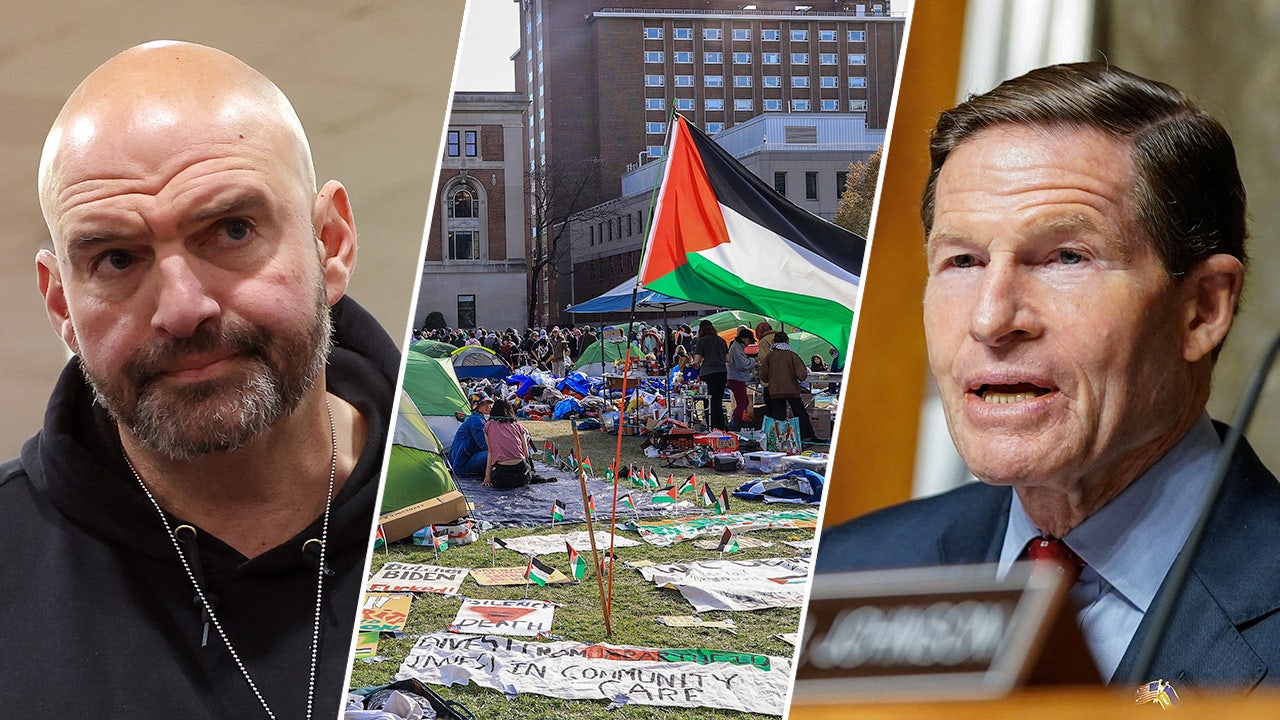
 Politics1 week ago
Politics1 week agoDems disagree on whether party has antisemitism problem
-

 Politics1 week ago
Politics1 week agoHouse Republicans brace for spring legislative sprint with one less GOP vote
-

 World1 week ago
World1 week agoAt least four dead in US after dozens of tornadoes rip through Oklahoma
-

 Politics1 week ago
Politics1 week agoAnti-Trump DA's no-show at debate leaves challenger facing off against empty podium
-

 Politics1 week ago
Politics1 week agoStefanik hits special counsel Jack Smith with ethics complaint, accuses him of election meddling
-

 News1 week ago
News1 week agoAs student protesters get arrested, they risk being banned from campus too

